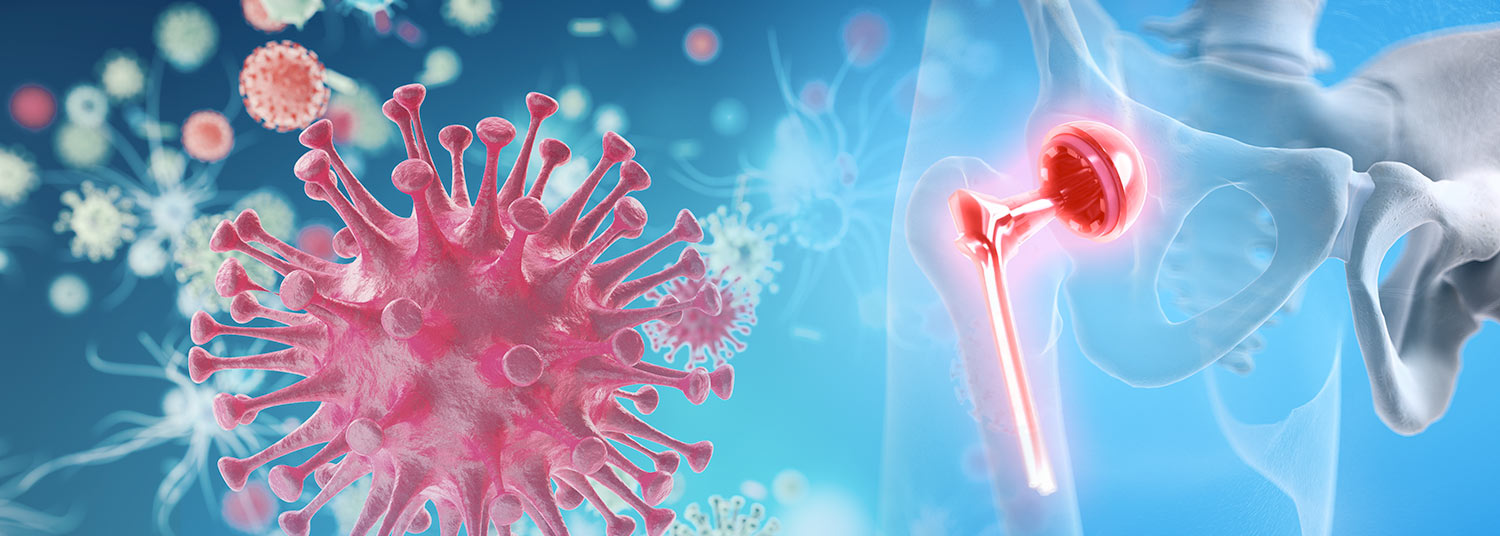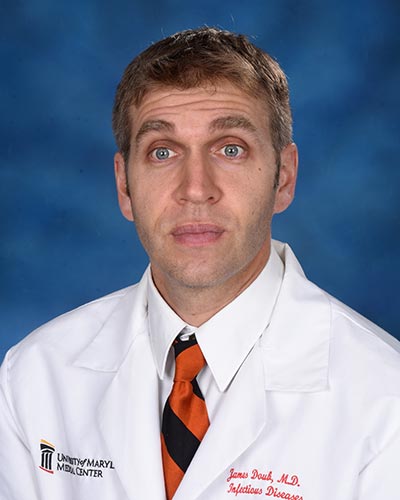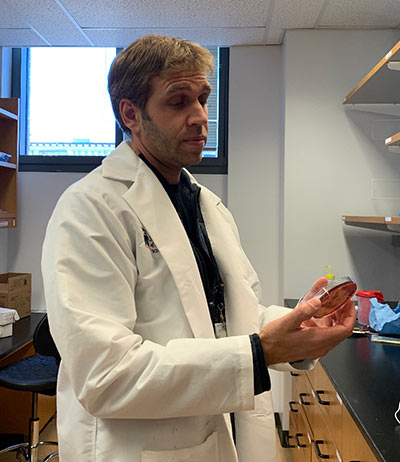
Researchers Are Developing Promising Solutions to Bacterial Biofilms and Antibiotic Resistance
Bacteria are becoming increasingly resistant to antibiotics. While several factors over many decades contributed to this dilemma, such as physician overprescribing, patients not taking their full course of pills, and even overuse in animals raised for food, one thing is clear: without new antibiotics or other creative solutions to treating infections, people will once again die from infections that were once easily treatable.
 Infections that develop in or around prosthetic joint replacements are particularly difficult to treat. The bacteria that cause these infections can form biofilms that behave as a barrier preventing antibiotics from interacting with the infected tissues and joint replacement surfaces which allows the infection to fester. Once antibiotics fail, physicians must surgically remove the prosthetic joint and scrape away infected tissues. This causes patients to have significant disability in that they are often left without a permanent joint for many months and complications such as bleeding and bones fractures can commonly occur during joint removal. Unfortunately, the five-year survival rates of these kinds of infections rival that of most cancers. As well, prosthetic joint infections cost the U.S. health care system well over $2 billion annually.
Infections that develop in or around prosthetic joint replacements are particularly difficult to treat. The bacteria that cause these infections can form biofilms that behave as a barrier preventing antibiotics from interacting with the infected tissues and joint replacement surfaces which allows the infection to fester. Once antibiotics fail, physicians must surgically remove the prosthetic joint and scrape away infected tissues. This causes patients to have significant disability in that they are often left without a permanent joint for many months and complications such as bleeding and bones fractures can commonly occur during joint removal. Unfortunately, the five-year survival rates of these kinds of infections rival that of most cancers. As well, prosthetic joint infections cost the U.S. health care system well over $2 billion annually.
One researcher at the University of Maryland School of Medicine’s (UMSOM) Institute of Human Virology (IHV), James Doub, MD, Assistant Professor of Medicine in IHV’s Division of Clinical Care and Research, is tackling this problem by developing a therapy using viruses that infect and kill bacteria in these prosthetic joint infections. These viruses that infect bacteria are called bacteriophages or phages for short, are found almost everywhere in the environment from the dirt to seawater, basically anywhere bacteria are found.
Dr. Doub is one of a handful of researchers in the world developing these therapies. So far, he has treated 11 patients with prosthetic joint infections through the US Food & Drug Administration’s expanded access pathway. A paper reporting these findings was published in August in Clinical Infectious Diseases.
“I started using phages to help treat patients that had end-of-the-road cases. These patients had tried all available antibiotics options and had undergone multiple surgeries, and they wanted to try a last- ditch-effort before undergoing amputation. These patients just wanted to be able to walk again and live functional lives,” said Dr. Doub. “Our early successes show that this is a promising therapy.”
For each patient, he figures out the kind of bacteria that is causing each infection. If more than one bacteria type is found, then the patient isn’t a candidate for phage therapy. Then, Dr. Doub sends the bacteria sample to his collaborators to be tested against various libraries of phages to find a phage that can kill the bacteria from the infection. His collaborators include researchers from Yale University, University of Pittsburgh and the companies Adaptive Phage Therapeutics (Gaithersburg, MD) and PhagoMed (Austria).
 It typically takes four to seven days to screen for an effective phage before they send him tubes each containing billions of phages. During surgery to remove damaged, infected tissue over the prosthetic, Dr. Doub applies phages directly onto the infection and into the joint. The patient also gets intravenous (IV) phage therapy after the surgery. For especially hard to treat cases, the orthopedic surgeon implants catheters in the joint, so he can apply phages directly to the infection on a daily basis.
It typically takes four to seven days to screen for an effective phage before they send him tubes each containing billions of phages. During surgery to remove damaged, infected tissue over the prosthetic, Dr. Doub applies phages directly onto the infection and into the joint. The patient also gets intravenous (IV) phage therapy after the surgery. For especially hard to treat cases, the orthopedic surgeon implants catheters in the joint, so he can apply phages directly to the infection on a daily basis.
“This research is using cutting edge technology for saving limbs when prosthetic joints are infected with resistant bacteria. Dr. Doub’s research has already provided hope for several of our patients,” said Shyam Kottilil, MBBS, PhD, Professor of Medicine, Director of the Division of Clinical Care and Research, Co-Director of the Clinical Care Research Unit at UMSOM's IHV. “Dr. Doub is expanding bacteriophage therapy to other diseases and conditions, which is quite remarkable and resourceful for many of our patients.”
Dr. Doub said that right now, given the U.S. Food & Drug Administration regulations, he is only able to treat the sickest patients, so patients may have improved outcomes if he could try the therapy earlier in the course of the infection. However, when trying new therapies, it’s typical that the agencies who regulate and fund these kinds of studies have the researchers first show a response in a patient group that has no other options before they will be allowed to try the therapy on someone not as sick.
 “First, we have to figure out a way to standardize the therapy to get the best results,” said Dr. Doub. “Then, we want to make the therapy more applicable to the general public as a standard of care and not just for patients who have no other option.”
“First, we have to figure out a way to standardize the therapy to get the best results,” said Dr. Doub. “Then, we want to make the therapy more applicable to the general public as a standard of care and not just for patients who have no other option.”
However, there are still a few lingering issues to first clarify to perfect this therapeutic. Although the bacteria samples from the infections may look the same or have the same genetic background, the environment may affect whether a phage works or not for an infection. Bacteria change their surface proteins and sugars depending on whether it is floating in the fluid in the joint or stuck on the surface of the joint prosthetic or muscle tissue. As phages use protein receptors on the outside of the bacteria to gain entry inside and infect bacteria, certain phages may be less effective in certain environments when surface proteins are altered.
Dr. Doub and his collaborator Ken Urish, MD, PhD, at the University of Pittsburgh were recently awarded a $1.3 million grant from NIH’s National Institute of Arthritis and Musculoskeletal and Skin Diseases (NIAMS) to study the sugars on the surface of Staphylococcus aureus in these different environments to determine how they affect the infectiousness of phages.
“My ultimate goal is to create effective, reproducible bacteriophage therapeutics to reduce disability and death associated with prosthetic joint infections, while also eventually applying our findings to other biofilm infections and antibiotic-resistant infections,” says Dr. Doub.
